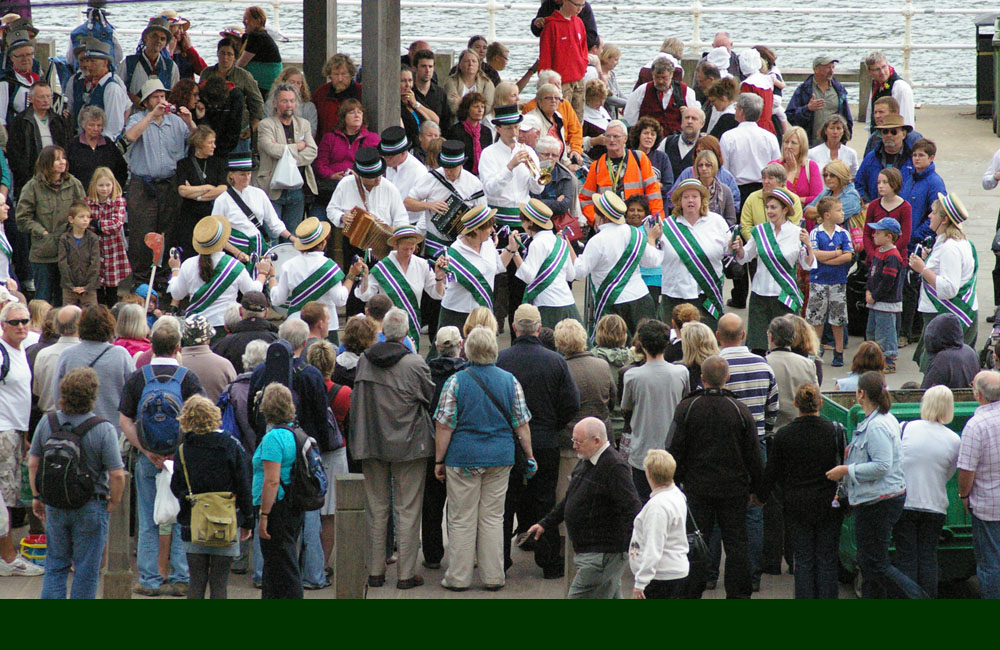All about Morris Dancing
Morris Traditions
Cotswold Morris

2012 Westminster Day of Dance, The Sanctuary, Westminster Abbey, London
copyright 2012 Woodside Morris Men
Cotswold is so called because its heartland, where Morris dancing can be traced back to the mid 17th Century, is in the south midland area of England, where the Cotswold Hills march through the countryside of Oxfordshire and Gloucestershire. Between the 18th and 19th Centuries, practically every village in this area seems to have been represented at some stage by a Morris side.
Cotswold dances consist of figures and choruses made up predominantly of single step (step hop) or double step (one, two three, hop) movements, but also featuring vigorous, more showy stepping, often involving leaping from foot to foot, with balances, splits and kicks thrown in for good measure. To accentuate the movements, dancers carry hankies or sticks which swirled or struck in time to the music. Cotswold sides also wear the Morris dancers' most famous accessory: the bells.
Jigs play quite a large role in Cotswold Morris, as its style lends itself very well to solo dances. Jigs are often used as proof of a novice's ability, and on performing satisfactorily in front of the team, a dancer may then receive their side's insignia, or baldricks.
Cotswold kit usually consists of white shirts and white trousers, or black breeches, usually with some kind of hat and a crossed sash, known as baldricks.
Northwest Clog Morris

2010 Whitby Folk Week, The Band Stand, Whitby
copyright 2010 Woodside Morris Men
North West dances are usually made up of a polka step, known as ranting, mixed with some single step (step hop), with the occasional bit of intricate stepping. although the tradition shares many figures and choruses with its southern cousin, in Northwest they tend to be more complex, sometimes resolving over a number of passages of the tune.
One of the most noteable differences between the two predominant traditions is the performance of music; whereas Cotswold sides are happy dancing with a single musician, North West teams tend to prefer as big a band as possible, with brass, drums, strings, wind and Melodeons. The lot.
An evolution of Northwest Morris that has continued without hiatus through the tewntieth century and into the twenty-first is Carnival Morris (also known as Fluffy and Competition Morris). The two styles are recognisably related but with Carnival Morris, the figures have become more regimented, reflecting the competition element that is essential to the tradition. Costumes have also continued to be modernised, as has the music, which tends now to be modern tunes played over a PA. Carnival Morris is not seen in general as part of the broader Morris family.
Border Morris
Many Cotswold sides will also dance Border, some of them even change their entire repertoire in winter to an all border set; there are further border/cotswold connections, with traditions such as Litchfield and Upton Upon Severn having a distinct border feel to them.

1980 Towersey Folk Festival, The Dance Arena, Towersey
copyright 1980 Woodside Morris Men
Many new sides have chosen to use Border as the root for variations on the Morris dancing theme, with some concentrating on the brightness of the stepping and intricate movements, some accentuating darker origins of the disquised dance in their attire and trappnigs, and some blooming in the daft side.
Molly Dancing
Molly comes from the Fenlands of Anglia, and although it is something of a loud minority Morris dance, it is very strong, and very dominant in its heartland. A raft of new teams around the area have joined the old timers in recent years with a definite sense of claiming the dance for their own.
Sword Dancing

1961 Woodside do Rapper, Cecil Sharp House, Camden Town
copyright 1961 Woodside Morris Men
At the end of a dance, and often within the dance as well, the set will lock their swords in a star pattern, which will be held aloft for audience approval, and when all is done, this locked star will often be thrown to the ground by way of a full stop.
Rapper is possibly the most vibrant and active arm of tradtional dance, not liking to be referred to as Morris, with the annual Dancing England Rapper Tournament (DERT) competition regularly attracting virtually the whole community! New teams seem to spring up all the time, with the competetive nature of DERT feeding a desire for high standards that other forms of dance find it difficult to sustain. Not neccessarily true for every team, but certainly for the majority.
Other Morris
There are a number of other forms of Morris dance, some of them not too keen on the link being made, despite their obvious relationship to the higher profile styles. The Brittania Coconut Dancers of Bacup have their own very distinct and unique style, with its own tales of origin, and traditions in performance - well worth catching. Then there is the Abbots Bromley Horn Dance and it's Thaxted homage, and the Hobby Horse traditions at Minehead and Padstow, which vary greatly from mainstream Morris. You then start crossing over into other local traditions such as Bonfire and Carnival that, whilst making no link to the Morris, do represent a common wish to maintain celebratory dance or spectacles evolved over centuries and owned by the people who participate in them.


